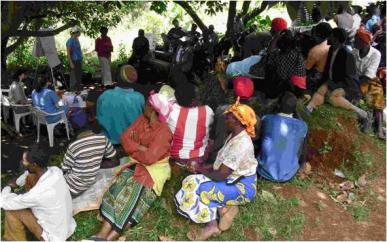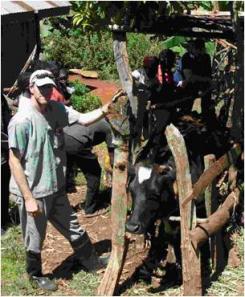 Vet team giving a seminar under a large avocado tree.
Vet team giving a seminar under a large avocado tree.
The January 2013 trip was a very successful trip again, with many animals receiving treatment or prevention interventions, many farmers being educated or assisted, three Canadian veterinary students receiving clinical training in treatment and health management of dairy cattle on smallholder farms, many animal health personnel receiving continuing education, and eight communities increasing in animal health, self-sufficiency, and quality of life due to our activities. During this visit, we worked with farmers of the Ex-Lewa Dairy Co-op (ELDC), Enderasha Dairy Co-op (EDC), Kiamaruga Dairy Group (KDG), Lunuru Dairy Co-op (LDC), Muthiru Dairy Co-op (MDC), Mukindu Dairy Group (MDG), Podago Dairy Co-op (PDC), and Wakulima Dairy Ltd. (WDL). There is a very strong desire for veterinary services and extension in these areas. The details of these activities are described in this summary report.
On January 19th, 2013, the “vet team”, including myself, and three senior vet students, Ari Verrilli, Fran Allan, and Melissa Moggy, left for Kenya with 6 suitcases full of veterinary medicine. Prior to leaving, various veterinary pharmaceutical companies, including Pfizer (now Zoetis), Merck, Boehringer, Merial, Bimeda, and Vetoquinol, provided product support for the project. These products were greatly appreciated by the veterinary team to enable them to provide suitable treatments for the animals that they encountered. The remaining products were left with the dairies to use after our return to Canada. This team was joined by a couple of veterinarians, Drs. Martha Mellish and Dave McRuer, from the USA who wanted to work with us for last week of our 3 weeks in Kenya, allowing us to spread our efforts out over even more farms.
While in Kenya in 2013, the veterinary team checked over 130 animals from over 100 farms over 15 working days, with the owners often wanting to give us mangoes, bananas, papaya, and passionfruit grown on their farms, and even eggs from their chickens, to show their appreciation. At each farm, numerous neighbouring farmers congregated, sometimes with a cow or calf in tote, to observe and ask questions regarding their cattle. It was estimated that over 500 farmers received health management information and/or services from the efforts. The major health problems observed included infectious diseases, parasite infestations, udder infections and insufficient nutrition, leading to low milk production, poor reproduction and inadequate growth.
Due to the national election scheduled in Kenya in March 2013, adjustments to university schedules made it impossible to include Kenyan veterinary students in the program this year, but we intend to include Kenyan veterinary students in the program again next year. The Canadian veterinary students still learned a lot from the Kenyan animal health technicians and veterinarian, particularly about life in Kenya, and the great challenges of international development work, self-sustainability, veterinary medicine and producing & marketing milk in poor, remote areas of Kenya. The Kenyan technicians learned about life in Canada and about some of the pertinent new techniques and theories of dairy cattle health management that are the product of recent research. Kenyans have limited access to recent research findings due to journal fees and internet “challenges”. The Kenyan technicians all received practical experience on the diagnosis, treatment, and prevention of common animal diseases and dairy management problems encountered in East Africa.
As this was the first year that our vet group worked with farmers of the Kiamaruga Dairy Group, and Enderasha Dairy Co-op, it was very interesting seeing the farm and management differences between these new groups compared to Wakulima Dairy Ltd. who have had many years of extension from Canadians in nutrition, agronomy, milk quality and animal health. There were many skinny calves and heifers and many cows with mastitis in Enderasha and Kiamaruga, but far fewer at the Wakulima farms. Also, the California Mastitis Test was not being used in Enderasha or Kiamaruga, with many episodes of rejected milk due to poor milk quality. There was strong need for extension and seminars in the new areas.
As with other years in Kenya, one highlight of the trip was the “walk-in clinic” for cattle in the Mbaria Market area near Kiirua where animals could be examined and treated if they were sick, or simply treated with a dewormer if they were healthy and not recently dewormed. When we arrived, there were already 20 cattle waiting for us. And that was a sign of things to come. Fortunately, we had a great system going, very efficiently moving cattle through the handling facilities, with help from other members of Farmers Helping Farmers. The final tally was over 300 animals dewormed and 40 sick animals examined and treated in one (long) day. “Dr. John” treating a cow with mastitis.
“Dr. John” treating a cow with mastitis.
Another highlight of
It is always wonderful to go to Kenya to work with the Kenyan people. They are so appreciative of what we offer, and such happy people, despite living in poverty. This attitude certainly helps us to put things in the right perspective, and to really appreciate what we have in Canada. I look forward to going back to Kenya again in 2014 to continue to assist these dairy groups toward self-sufficiency. Thank you again to all our supporters for your assistance in making this all possible.
By: Dr. John VanLeeuwen, Atlantic Veterinary College, UPEI - February 16, 2013